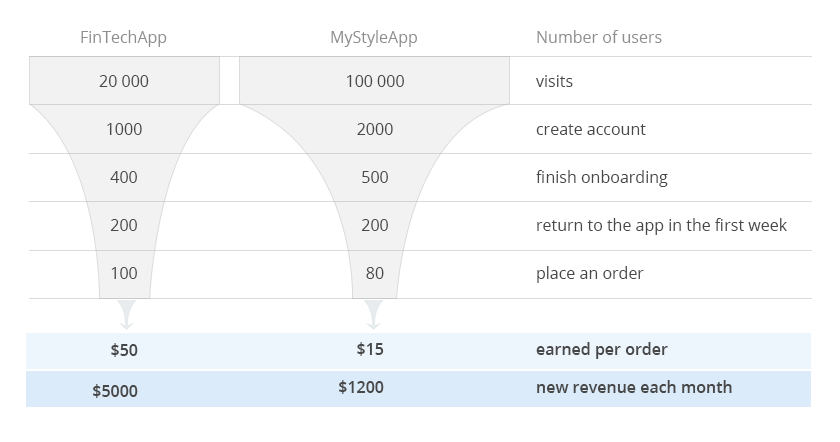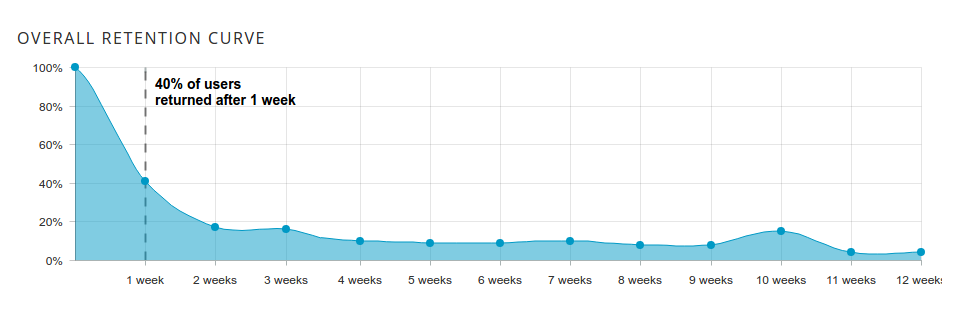This article is part 4 of 6 from our upcoming eBook: Hacking Growth With the Rule of 72. Pre-order your free copy and you’ll receive it automatically when it’s launched.
Follow the previous steps of the growth hacker’s journey:
Part 1: Increasing Traffic by 12%
Part 2: Increasing the Conversion Rate by 12%
Part 3: Increasing the Onboarding Rate by 12%
Is Customer Retention Relevant for SaaS?
Why is SaaS customer retention so important? Why should a product manager pay attention to this specific metric? You do need to get the users back into the app…

Well, you can’t really start charging a user for the service you’re providing until he has finished the onboarding process.
There’s usually a gap between the onboarding experience and the first payment, and that’s when customer retention must be taken into account.
In this article we show you how to optimize your SaaS retention rate and double your growth, with the rule of 72.
You need to make sure that users come back to the app after the onboarding process is completed, and that they keep coming back until the moment they are required to make a payment.
First off, you have to figure out what’s the exact time of the month when the users are making payments for the service you’re providing.
Once you learn that, you can begin to set your focus on the new users from the current month who are just about to be fully onboarded.
In order to drive growth of the app, you would have to make sure that those new users will still be hanging around during the time when the old users are making their monthly payments to your app.
Check out this detailed infographic if you want to see some mind boggling stats about the costs of customer acquisition vs. user retention.
Customer Retention Optimization
Now let’s see how this would be implemented for the two SaaS companies we’ve also used as examples in the earlier installments of this series. Here is their sales funnel.

Let’s see how our B2B and B2C apps would approach their customer retention optimization:
Customer Retention Optimization for B2B
The first thing FinTechApp has to figure out is how much time it takes for their onboarded users to make their first payment to the app.
Because they have custom reports generated by InnerTrends, FinTechApp is able to analyze the activity of their users and and see that, on average, it takes 3 weeks from the moment a user becomes onboarded, until he makes the first payment.

The next step would be to check how many users are still coming back to the app after those 3 weeks.
We know that our first week retention rate is 50% and it drops down to 35% by the third week, which means that only 140 users are coming back during the third week.
Increasing the retention by 12% would mean that FinTech would need to have 39.2% of its users return to the app in the third week, translating into an increase the amount of returning users from 140 to 157.
How to Increase SaaS Retention Rate by 12%
After analyzing FinTechApp’s analytics reports from InnerTrends we know that only 140 out of 200 users are currently returning to the app.
In order to increase the app’s retention, we would need to have a look at those 60 users who didn’t return between the first and the third week.
Now that they’ve narrowed down the exact chunk of users they need to target, FinTechApp simply needs to win back 17 of them in order to increase the retention by 12%
The goal behind this step is twofold:
- Recover the 17 users needed to increase retention by 12%
- Find out what needs to be implemented in order to make the next campaign automatic
Let’s have a look at a couple of viable strategies you could implement to help you find out the reason why some of the users aren’t returning to the app:
- Get your users on the phone. It doesn’t matter how big your company is, they will appreciate it and you’ll be able to find out why they love your product.
- Follow up with an email and ask them what have they been up to and if they ran into any trouble while they were using the product.
- Send out a survey with open-ended questions. This tactic is worth mentioning, even though we’ve seen it work best for apps with a larger numbers of users.
Which of these options is the best fit for FinTechApp? Let’s see what resources they would have to allocate for each of them.
1. Get your users on the phone
FinTechApp’s data shows that they can target 60 of their users. Since their goal is to identify exactly what’s making the users forget about the app, they will need to spend some time figuring out the pain points that the users might have.
It would be fair to say that these calls could each take up to 30 minutes.
With the 60 calls they have to make, stretched out to 30 minutes each, it would translate into a total of 30 hours that FinTechApp’s team would have to invest if they want to reach out to every single user.
2. Follow up with an email
Maybe the users had different expectations. This method of reaching out might not be as effective as calling them, but it’s the next best option if you can’t get them on the phone.
The average email open rate for the Software and Web App industry is 21%, with a click through rate of 2% according to MailChimp.
We’ve also found some benchmark data shared by HubSpot where they break down the email open and click through rates by B2B vs B2C, company size, and number of emails sent. The average open rate is 32%, with the click through rate of 6.4%
How many emails would FinTech have to send in order to get back their 17 users? If they target all the 60 eligible users with a single campaign, only 19 of them would open the email, and 3 would click through.
So how many emails would FinTech have to send in order to get 17 users to click through? 283, if we are to run the numbers by HubSpot’s benchmark data.
Since FinTechApp are only emailing 60 people, it’s pretty obvious that investing the time to talk to users on the phone is going to be the most effective method. However, both email and surveys are an option to keep in mind as the app grows.
By taking into account how FintechApp’s customer retention rate decreases during the second and third week, it’s very likely that you will discover an issue that is related to one of the features of the product.
Maybe there’s something that’s missing from it, or the users aren’t able to see how a certain feature actually helps them. Be sure to keep this in mind when you get your customers on the phone.
Once you get it fixed, it should help that chunk of users stick around for the long term.
Customer Retention Optimization for B2C Apps
Now let’s see how this would work out for our MyStyleApp.

MyStyleApp analyzes the same report in InnerTrends which tells us that, for this app, users make their first payment during the first week after they become onboarded.
This means that MyStyleApp’s approach to optimize this app’s retention will be completely different from the previous one.
MyStyleApp should focus strictly on first week retention optimization in order to reach the goal. Let’s see what you can do to increase it by 12%.
If we have 200 users who return during the first week out of 500 who finish the onboarding, it means that our app has a first week retention of 40%.
In order to increase it by 12%, we would need to get 224 users back to the app during the first week, instead of the 200 they already have.
This would translate into a first week customer retention rate of 44.8%.
How many emails would Fashion App have to send considering HubSpot’s benchmark data shows the industry’s open rate at 32%, and a click rate of 6%?
They would have to send 400 emails.
Sending your users reminders, incentives to come back, or designing a winback campaign are a couple of things you try to get them to return to the app.
Here are some of our favorite examples of how other SaaS companies put this strategy to work:
- 13 Templates for Significantly Better Lifecycle Emails
- 6 Awesome Examples of Win-Back Email Campaigns
- How to Win Back Your Lost Trial Leads
It is worth mentioning that, out of all the retention scenarios an app can go through, the one we see here for MyStyleApp is the easiest to optimize for growth.
There are a couple of other retention scenarios that an app can go through. We’ve only talked about two of them here because we already wrote a comprehensive retention optimization guide specially tailored for the needs of growth hackers.
Now that you’ve learned how to make your app so sticky that your users won’t be able to forget about it, it’s time to increase the purchase conversion rate by 12%. We’ll show you how in Part 5.
Looking for deep insights into how your customers use your product?
InnerTrends can help. You won’t have to be a data scientist to discover the best growth opportunities for your business, our software will take care of that for you.
Schedule a Demo with us and witness with your own eyes just how powerful InnerTrends can be.